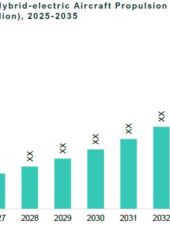Description
Introduction to Advanced Space Composites Market
The advanced space composites market is swiftly gaining prominence as a pivotal sector within the aerospace industry, driven by the escalating demand for lightweight and high-strength materials to revolutionize space exploration and satellite technologies. Composites are materials composed of distinct elements combined to achieve superior mechanical, thermal, and structural properties, offering unprecedented opportunities to enhance the efficiency and capabilities of spaceborne systems.
Within this market, various segments stand out, each contributing to the transformation of space technologies through the innovative use of advanced composites. Satellite structures and components represent a critical sector where composites play a pivotal role in constructing lightweight yet robust frameworks that withstand the rigors of launch, vacuum conditions, and thermal extremes. These materials enable the development of larger and more complex satellites, accommodating advanced payloads and expanding communication, Earth observation, and scientific capabilities.
Composite materials find extensive application in the fabrication of rocket structures, contributing to weight reduction, enhanced fuel efficiency, and improved overall performance. This segment encompasses composite fairings, interstage, and even propellant tanks, where high-strength, low-weight materials are essential to facilitate cost-effective and reliable access to space.
Advanced propulsion systems constitute a significant segment focusing on harnessing the benefits of composites to create high-performance, lightweight propulsion components. From nozzle assemblies to tanks for liquid propellants, composite materials offer the strength-to-weight ratio necessary for achieving efficient thrust and maneuverability while ensuring the structural integrity required for space missions spanning from Earth’s orbit to interplanetary travel.
The realm of space habitat construction and interplanetary exploration also sees the integration of advanced composites to design and fabricate durable systems for extended missions in lunar and interplanetary scope. These materials provide protection against radiation, micrometeoroid impacts, and temperature fluctuations while allowing for modular construction and adaptability to different planetary environments.
The advanced space composites market stands as a driving force behind the transformation of space technologies, offering an array of materials and fabrication techniques that challenge traditional aerospace paradigms. As humanity ventures further into the cosmos, the integration of advanced composites is poised to redefine the limits of what can be achieved in space exploration, satellite deployment, and realization of ambitious interplanetary endeavors.
Market Introduction
Advanced composites offer cost-effectiveness, ease of processability, high strength-to-weight ratio, multifunctionality, and diverse properties in terms of thermal insulation and ablation. High-modulus carbon fiber reinforced laminates are one of the major uses for many composite spacecraft applications.
In human crew capsules, composite panels are used to provide the thermal protection system (TPS) required for vehicle re-entry. The temperature capability and low thermal expansion offer additional benefits by reducing the amount of TPS material required, which reduces the weight of the vehicle. Carbon fiber laminates are widely used on satellites and payload support structures. For instance, satellite bus structures are made using aluminum honeycomb sandwich panels with either carbon fiber or aluminum face sheets.
Also, high-modulus, high thermal conductivity carbon fiber laminates with low moisture absorption resins, typically cyanate ester, are always used for manufacturing optical benches and other spacecraft structures, which must sustain dimensional stability for accuracy. These advanced composites help in maintaining extreme dimensional stability over extreme temperatures when the spacecraft is in space.
Apart from this, radio frequency (RF) reflectors and solar array substrates also use high-modulus carbon fiber laminates in order to achieve stiffness and dimensional stability.
There are several factors that contribute to the growth of the advanced space composites market. Technologies such as reusable launch vehicle systems, on-orbit manufacturing technologies, and upcoming space stations and habitats have the potential to further the use of advanced composites for space applications.
The companies operating in the advanced space composites market are highly engaged in research and development initiatives and have been investing in developing new innovative technologies that would enhance space systems. The convergence of visionary space agencies, pioneering private enterprises, and international partnerships underscores the momentum propelling the growth of the advanced space composites market.
Advancements in materials science, coupled with enhanced launch vehicle performance and reduced mission costs, have fuelled the market’s expansion, with emphasis placed on solving challenges pertaining to structural integration and lifecycle sustainability.
The market’s trajectory hinges on the resolution of these factors as the space industry increasingly seeks to capitalize on the transformative potential of advanced composites.
Market Segmentation:
Segmentation 1: by Platform
• Satellites
• Launch Vehicles
• Deep Space Probes and Rovers
Launch Vehicles to Dominate as the Leading Platform Segment
The advanced space composites market’s platform segment is led by the launch segment, with a 40.25% share in 2023. The application of advanced composite materials in launch vehicles has brought significant advancements, offering numerous benefits, including weight reduction, increased payload capacity, improved structural integrity, enhanced fuel efficiency, and enhanced performance. Launch vehicle manufacturers are now focusing on designing and developing smaller, less complex, reusable, and cost-efficient launch vehicles, which are facilitated by the growth of small satellites. However, with the rise in satellite launches in the past few years and the expected small satellite mega constellation in the next decade, it is anticipated that the satellites segment will register the highest growth during the forecast period 2023-2033. The satellites segment is expected to grow at the highest CAGR of 12.24% during the forecast period.
Segmentation 2: by Component
• Payloads
• Structures
• Antenna
• Solar Array Panels
• Propellent Tanks
• Spacecraft Module
• Sunshade Door
• Thrusters
• Thermal Protection
Structures Segment to Dominate the Global Advanced Space Composites Market (by Component)
The structures segment is expected to dominate the market during the forecast period from 2023 to 2033. The factor contributing to this growth is the increased focus of space companies to develop reusable launch vehicles as well as small launch vehicles (SLVs).
Segmentation 3: by Material
• Carbon Fiber
• Glass Fiber
• Thermoset
• Thermoplastic
• Nanomaterials
• Ceramic Matrix Composites (CMC) and Metal Matrix Composites (MMC)
• Others
Carbon Fiber Segment to Lead the Global Advanced Space Composites Market (by Material)
The advanced space composites market’s material segment is led by carbon fiber, with a 31.1% share in 2023. Carbon fiber composites have been used by the space industry for several decades and are continuously being used for several space applications, including launch vehicles, satellites, experimental systems, suborbital vehicles, and deep space probes. Recent advancements in carbon fiber manufacturing techniques have enhanced its flexibility, resulting in the introduction of novel carbon fiber types with improved modulus and strength tailored for space system applications.
Segmentation 4: by Manufacturing Process
• Automated Fiber Placement (ATL/AFP)
• Compression Molding
• Additive Manufacturing
• Others
Segmentation 5: by Service
• Repair and Maintenance
• Manufacturing
• Design and Modeling
Segmentation 6: by Region
• North America
• Europe
• Asia-Pacific
• Rest-of-the-World
Europe is the highest-growing market among all the regions, registering a CAGR of 13.09%. European countries are known for their expertise in space research and development, with multiple renowned space agencies, primordially the European Space Agency (ESA), playing a pivotal role in space exploration and technology development. These agencies collaborate with industry-leading companies, research institutions, and universities to drive innovation and push the boundaries of advanced space composites’ performance. The European Space Agency (ESA) introduced the SpaceCarbon project under the Horizon 2020 Programme. This project’s objective is to develop Europe-based carbon fibers (CF) and pre-impregnated materials for launchers and satellite applications.
Recent Developments in the Global Advanced Space Composites Market
• In July 2023, Orbital Composites won a $1.7 million contract from the U.S. Space Force to develop its technological capabilities to facilitate in-orbit manufacturing of satellite antennas.
• In June 2023, Beyond Gravity won a contract from ESA to develop the payload fairing for the Ariane 6 launch vehicle. The payload fairing is 14 meters and 20 meters tall for the respective variants of the launch vehicle and will have a standard diameter of 5.4 meters.
• In November 2022, MT Aerospace AG won a $33.5 million contract from ESA for developing demonstrator systems made of carbon fiber-reinforced polymer (CFRP) for the Prototype for a Highly OptimizEd Black Upper Stage (PHOEBUS) project, which would be incorporated in the Innovative Carbon Ariane Upper Stage (ICARUS) of the Ariane 6 family of launch vehicles.
• In October 2022, Beyond Gravity won a contract to supply 38 payload fairings for ULA’s Vulcan rockets, which would be used to launch the satellites of Amazon’s project Kuiper.
• In March 2022, Beyond Gravity and Amazon announced a partnership to develop and manufacture customized composite satellite dispenser systems for Project Kuiper. The project aims to establish a low Earth orbit (LEO) constellation comprising 3,236 satellites.
Demand – Drivers, Challenges, and Opportunities
Market Demand Drivers:
The surging number of satellite launches and the increasing scope of deep space activities is driving the requirements for advanced space composites. The advanced space composites industry stands poised for significant expansion. Companies specializing in advanced composites, equipped with deep expertise in composite manufacturing processes, material development, and structural design, are strategically positioned to capture the array of opportunities that this burgeoning market segment has. By delivering cutting-edge composite solutions tailored to the specific needs of space missions, these companies can propel technological advancements, elevate mission capabilities, and actively contribute to the advancement of space exploration.
Market Challenges:
The high cost associated with space composites poses a significant business challenge for the advanced space composites industry. While these materials offer exceptional performance and unique properties necessary for space applications, their production, development, and implementation can be prohibitively expensive. One of the primary contributors to the high cost of space composites is the intricate manufacturing process. Advanced space composites often require specialized manufacturing techniques, such as filament winding, autoclave curing, or additive manufacturing with high-performance polymers or carbon fibers. These techniques involve complex machinery, precise control of environmental conditions, and skilled labor, all of which contribute to elevated production costs. Additionally, the stringent quality control and testing requirements for space-grade composites further increase expenses. These factors also add inflexibility for rapid component development in hardware-rich approaches.
Market Opportunities:
Manufacturing complex composite structures using conventional methods presents significant challenges in terms of difficulty and time consumption. However, additive manufacturing offers a solution by enabling precise layer-by-layer deposition of composite materials, allowing for the creation of geometrically complex and specialized structures. This innovative technology enables the fabrication of internal features and graded material compositions that are otherwise difficult or impossible to achieve using traditional subtractive manufacturing techniques. The field of additive manufacturing for composites has seen notable advancements, including the utilization of novel feedstock materials such as continuous fibers, nanoparticles, and functional fillers, which enhance the mechanical, thermal, and electrical properties of printed composites. Furthermore, the development of hetero-material and differential method printing capabilities has expanded the design possibilities and performance of composite materials for space applications.
How can this report add value to an organization?
Product/Innovation Strategy: The product segment helps the reader to understand the different types of solutions available for deployment and their potential globally. Moreover, the study provides the reader with a detailed understanding of the advanced space composites market by technology, inclusive of the key developments in the respective segments globally.
Growth/Marketing Strategy: The advanced space composites market has seen some major development by key players operating in the market, such as partnership, collaboration, and joint venture. The favored strategy for the collaboration between government space agencies and private players is primordially contracting the development and delivery of advanced materials and specialized composite components for space system applications. For instance, in June 2023, ESA contracted Beyond Gravity to fabricate and deliver the payload fairing for the Ariane 6 launch vehicle in two configurations.
Competitive Strategy: Key players in the advanced space composites market have been analyzed and profiled in the study, inclusive of major segmentations and service offerings companies provide in the technology segments, respectively. Moreover, a detailed competitive benchmarking of the players operating in the advanced space composites market has been done to help the reader understand how players stack against each other, presenting a clear market landscape. Additionally, comprehensive competitive strategies such as partnerships, agreements, and collaborations will aid the reader in understanding the revenue pockets in the market.
Methodology: The research methodology design adopted for this specific study includes a mix of data collected from primary and secondary data sources. Both primary resources (key players, market leaders, and in-house experts) and secondary research (a host of paid and unpaid databases), along with analytical tools, are employed to build the predictive and forecast models.
Data and validation have been taken into consideration from both primary sources as well as secondary sources.
Key Market Players and Competition Synopsis
The companies that are profiled have been selected based on thorough secondary research, which includes analyzing company coverage, product portfolio, market penetration, and insights that are gathered from primary experts.
In the global advanced space composites market, established commercial players and legacy companies account for 65% of the market, and small-scale players and startups account for 35% of the market. The primordial established commercial players and legacy companies are Toray Advanced Composites, Beyond Gravity, Hexcel Corporation, Airborne, and MT Aerospace AG, among others. The primordial small-scale players and startups include Orbital Composites, ST Advanced Composites Pvt Ltd., Scorpius Space Launch Company (SSLC), and Infinite Composite Technologies, among others.
Key Companies Profiled:
• Airborne
• Beyond Gravity
• CRP Technology S.r.l
• EURO-COMPOSITES
• Hanwha Cimarron
• Hexcel Corporation
• MT Aerospace AG
• Opterus Research and Development
• Rock West Composites, Inc.
• Teijin Limited
• Toray Advanced Composites




